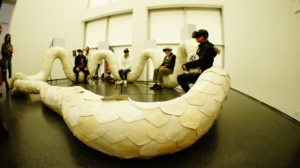You have no items in your cart. Want to get some nice things?
Go shopping
Museums have always been at the forefront of technology, and have used the latest developments to look to the past. Modern exhibits have the power to take you back in time, just like how the Design Museum turned 2017 into 1917 through the Imagine Moscow exhibit. However, in the day and age of the Internet where young people are used to rich, complex multimedia experiences and you can get almost everything you need online, have museums and art galleries become irrelevant? Curators are now in a race to find a way to make museums more compelling and engaging. The American Alliance of Museums recognises that smart technology is the key—from how it can help improve visitor experience to how it can serve as a powerful tool for managing and mining archives.
Here are some museums that already use the latest tech for their exhibits:
The Science Museum
If you feel a great love for everything science, from the latest advances in modern technology to the social and ethical impact of these developments, you need to come and see Tomorrow’s World at The Science Museum. You can retrace the 400-kilometre journey back to Earth from the ISS with Tim Peake, European Space Agency’s first British astronaut, through the museum’s impressive VR technology.
Tate Britain
In 2014, Tate Britain let the public inside the museum after dark—not physically, but through four camera-equipped robots that could be controlled wherever you are in the world. The Guardian reports that only a few lucky people were chosen and given the chance to control the robots, navigating around the Tate Britain building, going from one collection to another while the rest of the world watched on the After Dark web app.
Tate continues to celebrate the union of art and tech by consistently featuring artists who have used machines within their work, whether it’s electronic technology, light and graphics, or robots and sounds.
The National Gallery
At The National Gallery, you don’t need a guide to help you appreciate the beautiful exhibits onsite. Just download the Smartify app, hold your smartphone up towards a painting and you will be able to see detailed information about the artwork. You can also save the paintings you have scanned and share them with others who have signed up to the platform.
The Victoria and Albert Museum
If you want to see for yourself what the world would look like a few years from now, you can stop by The Victoria and Albert Museum. Their recent exhibits showcase 100 projects that are currently shaping the future. The exhibit called The Future Starts Here includes a range of things, from smart appliances to satellites as well as artificial intelligence and the current Internet culture. They also ask pertinent questions like how design can stop climate change and whether or not trees could start transmitting the Internet.
You don’t even need to go to a museum to learn about important people and events in UK history. Just download the EHC app, go to the heritage sites across the country and through augmented reality, you will be transported back in time to significant moments in UK history.
Smart tech has truly gone a long way when it comes to improving user experience. Not only in the field of business, health, science, transportation, and entertainment, but in ordinary homes, too. A connected home allows you to control vital home functions and perform simple tasks that can make your home safer and more energy efficient at just a touch of a button. Screwfix features an array of smart home devices that show the different ways the technology can be integrated into a living space. It can range from smart bulbs, speakers, and plugs, to smart heating controls, security cameras, and alarms. Where once this technology was on display in science museums, now it has become the domestic reality that was once promised to consumers.
We live in a world that was once only found within the pages of science fiction. Yet, as the world moves forward, more wonders are becoming available to help us understand the past. The good news is that museums and galleries will continue to keep up.





